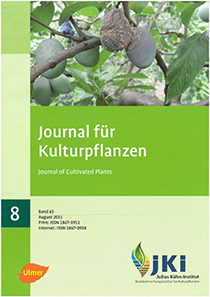Agricultural weather stations: Comparison of on-the-spot weather data with those from surrounding official weather stations
Keywords:
weather, climate, agricultural weather station, comparison of weather data, statisticsAbstract
Weather information are important tools for agriculture. Weather data obtained over ten years at the experimental field of the Julius Kühn-Institut in Dahnsdorf (Potsdam-Mittelmark rural district, federal Land of Brandenburg) were compared with those from surrounding official weather and precipitation stations of Deutscher Wetterdienst (Germany’s official meteorological service). The results were statistically analyzed from various points of view and using different methods.
The following conclusions were drawn:
In general, weather data from the agricultural weather station and from the surrounding official weather and precipitation stations are closely correlated. Correlation coefficients depend on the meteorological parameter itself, the time interval under investigation and the station. Hourly values show coefficients of 0.97 to 1.00 (air temperature), 0.83 to 0.86 (relative humidity) and 0.16 to 0.22 (precipitation). The strongest correlations are found in particular for the total time interval. Individual parameters limited in time (as for instance relative humidity before sunrise) may vary enormously.
Differences result from spatial distance, altitude of the stations and local conditions of direct vicinity (exposure, buildings, plants). Effects of these parameters overlap each other. And they vary depending on the meteorological parameters.
Additional information from an on-spot agricultural weather station is gained in particular when considering smaller time intervals (for instance hours). Medium differences of air temperature between the agricultural weather station and the DWD station vary from –0.48 K (Magdeburg) to +0.50 K (Wiesenburg).
In case of condensed data (daily and monthly values) it is useful to choose a representative station. A comparison shows that such a station should not necessarily be the closest one.
Referring to the experimental field at Dahnsdorf, air temperature and humidity, for instance, better correspond with the more distant stations at Wittenberg (28.5 km) or Potsdam (40.0 km) than with the closer one at Wiesenburg (14.0 km) which is however more exposed. In this case meteorological parameters are stronger influenced by altitude than by distance.
This is not true of precipitation, which varies strongly with distance. Differences are clearly dependent on distances between the stations. Total daily precipitation may considerably vary in part. For instance, a daily sum of minimum 2 mm precipitation was identified at Dahnsdorf. Comparing the individual values with those from the DWD stations and measuring points, 18.6% (for Niemegk, at 3.3 km distance) up to 61.2% (for Magdeburg, at 71.9 km distance) of them differ by minimum 2.0 mm. The frequency of exceeding defined differences of precipitation (ΔRR) and the distance among the stations can be shown as logarithmic function with high coefficient of determination (R2 = 0.90 … 0.94).
Further studies are required to analyze possible influences of mesoclimatic differences between a larger field (experimental field at Dahnsdorf) and a developed area (DWD stations) on mathematic-numeric models (infestation, growth, yield or meteorological parameters).
DOI: 10.5073/JfK.2011.08.03, https://doi.org/10.5073/JfK.2011.08.03








